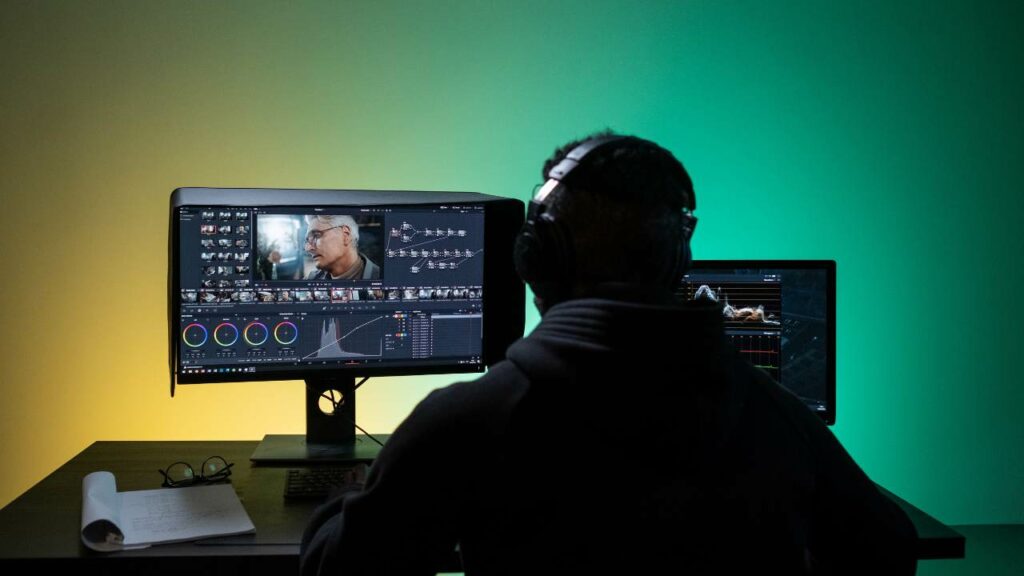Creating compelling corporate videos is an art form – a powerful tool to catapult your business into the limelight. But how do you ensure your video leaves a lasting impression? By adhering to a systematic approach.
Herein lies your guide, a handy checklist that streamlines the process of corporate video production, bringing your business objectives into sharp focus and ensuring a masterpiece that resonates with your audience. Let’s dive in!
Understand Your Goals and Objectives
Producing a successful corporate video requires a clear understanding of your goals and objectives. Before diving into the production process, it is essential to establish what you hope to achieve with the video. This could be anything from promoting a specific product or service to increasing brand awareness among a target audience.
One way to create effective goals is by following the SMART criteria, which ensures your objectives are Specific, Measurable, Achievable, Relevant, and Time-bound. For example, instead of setting a vague goal like “increase online engagement,” a SMART objective would be “use video content to grow my subscribers by 15% over the next three months” 1.
To help you set clear objectives for your corporate video, consider the following steps:
- Identify the purpose of your video: Are you looking to launch a new product, communicate your company’s values, or provide employee training? Understanding the main purpose will help you create a focused message.
- Define your target audience: It’s crucial to know who you want to reach and tailor your content to their needs and preferences. This could be potential customers, existing clients, or internal employees.
- Craft a compelling message: Determine the key points you want to convey in your video and create a concise script that communicates these points effectively.
- Establish Key Performance Indicators (KPIs): To measure the success of the video, set measurable business objectives that align with your overall goals.
Identify Your Target Audience
To master the art of video production, first you need to identify your target audience. By doing so, you ensure that your video content aligns with the interests and preferences of the intended viewers. This process begins with thorough research to gain insight into the demographic characteristics and preferences of the potential audience.
Start by defining the specific audience you want to reach with your video. Consider factors such as age, gender, location, occupation, and interests. Identifying these demographics will help tailor your video to better resonate with the target audience.
For example, if your video is intended to promote a product designed for young professionals, your content should highlight the benefits that appeal to their busy and ambitious lifestyles.
In addition to demographic factors, researching your target audience’s online behaviour can provide valuable insights. Explore the social media platforms, forums, and blogs they frequent to better understand their preferences and interests. This will help you create content that captures their attention and fosters engagement.
Once you’ve gathered sufficient information on your target audience, it’s time to ensure that your video content addresses their specific needs and desires. For instance, if your research reveals that your audience is interested in sustainability and environmental issues, emphasise the eco-friendly aspects of your product or service.
Scripting and Storyboarding
Before embarking on producing a corporate video, it is essential to go through the pre-production phase, which incorporates scripting and storyboarding. These critical steps help convey the key messages efficiently and in an engaging manner.
A solid script ensures that the story and dialogue are well-structured and align with the video’s objectives. To write an effective script:
- Understand the audience and their needs.
- Identify the ultimate goal of the video.
- Determine the key messages to be delivered.
- Develop a compelling narrative.
- Finalise the dialogue, voiceovers, and other audio elements as needed.
Once the script is ready, the next step is to create a storyboard. A storyboard serves as a visual guide throughout the production process, providing a clear roadmap for each scene. To construct a successful storyboard:
- Sketch out the key scenes to represent the video’s storyline.
- Determine camera angles, shot types, and transitions between scenes.
- Identify any required visual effects or graphic elements.
- Include brief descriptions of the action or dialogue taking place in each frame.
- Incorporate any necessary annotations or production notes for the filming crew.
Budget and Schedule
Establishing a budget for a corporate video project is an essential step in ensuring a successful outcome. First, consider the overall event or campaign budget and allocate a portion to the video production.
A rough guideline is to allocate about 7.5% of the total event budget to the video production. Keep in mind that production costs can vary greatly depending on the project’s scope and requirements.
If money is tight, our essential guide to DIY video production on a budget will be of great use.
Assembling the Production Crew
When producing a corporate video, an essential step is assembling a skilled and efficient production crew. To ensure a successful video shoot, select a crew that is adept at handling their respective roles and responsibilities.
First, consider the camera crew, which includes the director of photography (DoP) and camera operators.
The DoP is responsible for the visual style and quality of the video, whereas camera operators are tasked with capturing the required shots based on the shot list. Both roles require individuals with technical expertise and experience in working with various camera equipment.
Another crucial aspect of the crew is sound recording and management. Sound engineers or audio technicians are responsible for this task. They handle the recording, mixing, and supervision of audio using high-quality microphones and other audio equipment. This ensures clear and well-balanced audio in the final video.
Casting is also an important part of the production process. This involves selecting the right talents, such as actors, narrators, and presenters, who can effectively convey the video’s message and align with the intended tone and style.
This process not only ensures the final video is engaging but also helps create a professional image for the corporate brand.
Selecting the appropriate equipment is essential in producing a high-quality corporate video. Some critical considerations in equipment selection include:
- Camera: Choose a camera based on resolution, dynamic range, and other features that suit the project’s requirements.
- Microphone: Select microphones that capture clear and crisp audio based on the environment you are filming in.
- Lighting: Proper lighting equipment is crucial in setting the scene and controlling the visual mood.
- Support gear: Tripods, dollies, gimbals, and sliders help stabilise and manoeuvre the camera for smooth and dynamic shots.
Pre-Production Tasks
Before embarking on the production of a corporate video, it is essential to lay the groundwork during the pre-production phase. This phase encompasses important tasks like research, defining the style and tone, and planning the elements such as animations and graphics.
Style and Tone
Determining the style and tone of the video is crucial as it will establish the visual representation and the overall atmosphere of the content. The desired style could be professional, casual, or even humorous, depending on the intended target audience and company brand. The tone should be in line with the overall message and the company’s brand voice.
Storyboarding and Scripting
A crucial step in pre-production is developing a storyboard that outlines the visual elements and corresponding narrative. This helps streamline the production process and ensures that the final product aligns with the initial concept. Alongside storyboarding, scripting the dialogue or voice-over is essential for an engaging and coherent narrative.
At this stage, it’s also important to finalise the video’s intended length, keeping in mind the target audience’s preferences and the platform where the video will be distributed.
Production and Filming
The process of producing corporate videos starts with planning and pre-production, followed by the actual production and filming stage. In this section, we shall discuss the key aspects of production and filming to ensure a successful outcome.
Firstly, it is essential to determine the type of video you want to produce. The type of video you create depends on your target audience and the specific goals you aim to achieve. Common types of corporate videos include training and recruitment videos, testimonials, broadcast commercials, social media content, explainer films, and branded content.
Next, consider the preferences and expectations of your audiences. This is crucial in guiding the style, tone, and content of your corporate video. Tailor your video to your intended viewers, keeping their interests, preferences, and key concerns in mind.
When it comes to the actual filming, ensure you have the right camera equipment for the task. Your choice of camera will depend on your budget, the desired production quality, and the specific requirements of your type of video. Remember, investing in higher quality equipment may be more cost-effective in the long run as it significantly impacts the final product’s quality.
Effort should be placed in coordinating different elements, such as lighting, sound, and location, to create a visually appealing and impactful video. Pay attention to details like background noise, visual distractions, and colour schemes, as these factors can either elevate or undermine your video’s effectiveness.
Distribution and Marketing
When it comes to producing corporate videos, ensuring proper distribution and marketing is crucial for success. One of the key platforms to leverage for video marketing is YouTube, the second-largest search engine, which is used to showcase videos to a wider audience.
Before beginning distribution, it is important to identify the target audience and select the most suitable distribution channels to reach them. This may include social media platforms, email campaigns, or even sharing the videos on company websites.
To maximise engagement, it is essential to create captivating titles, descriptions, and thumbnails for the videos. Integrating keywords related to the video’s topic can help to optimise it for search engines and increase its reach.
Here are some key aspects to consider when creating a marketing strategy for your corporate videos:
- Platform Selection: Choose the appropriate platforms to distribute your video, such as YouTube, Facebook, or LinkedIn, depending on your target audience.
- Video Length: Tailor video duration to suit the platform, taking into consideration audience preferences and attention span.
- Consistent Messaging: Ensure that the videos align with overall company messaging and include clear calls-to-action.
- Cross-Promotion: Utilise different channels to promote the video, such as blogs or social media, for maximum reach and engagement.
- Scheduling: Plan video releases strategically to coincide with relevant company milestones or trending industry happenings.
Takeaway
In conclusion, corporate video production is a versatile tool that can serve various objectives for businesses in different industries. From promoting products and services to training employees and communicating company updates, the possibilities are vast.







